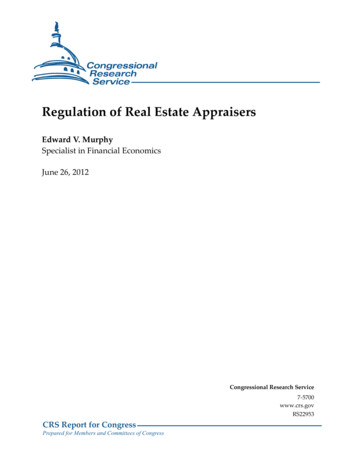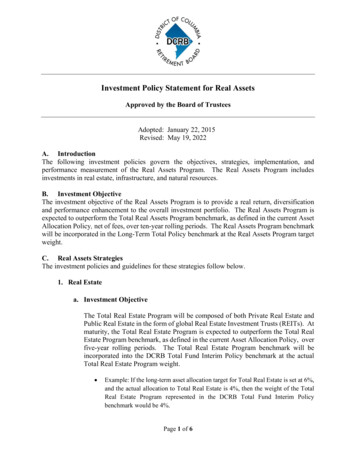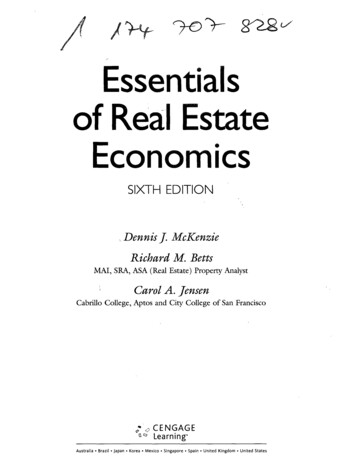
Transcription
Regulation of Real Estate AppraisersEdward V. MurphySpecialist in Financial EconomicsJune 26, 2012Congressional Research Service7-5700www.crs.govRS22953CRS Report for CongressPrepared for Members and Committees of Congress
Regulation of Real Estate AppraisersSummaryReal estate appraisers attempt to measure the value of a property that is being purchased orrefinanced. In mortgage contracts, the property serves as collateral for the loan. Banks and theirregulators may rely on the appraisal to reduce the potential losses if the borrower fails to repaythe loan. Property purchasers may also rely on an appraisal if they wish to reassure themselvesthat the price they offered was reasonable given market conditions. This report discusses theregulation of appraisers and provides information on related statutes and rules.The fallout from the housing bubble raised questions about the effectiveness of the regulation ofresidential real estate appraisers before and during the financial crisis. Real estate prices roserapidly in some areas, then fell rapidly. When the real estate bubble burst, questions arose aboutthe accuracy of the appraisals that supported the mortgage loans during the housing bubble.Traditionally, regulation of real estate appraisers was handled at the state level, with a federalagency, the Appraisal Subcommittee (ASC), overseeing the state boards that licensed andcertified appraisers. The Dodd-Frank Wall Street Reform and Consumer Protection Act (DoddFrank Act, P.L. 111-203) increased federal requirements for real estate appraisers and transferredsome federal oversight powers from banking regulators to the new Consumer Financial ProtectionBureau (CFPB).The Appraisal Foundation, a professional organization, issues the specific standards forconducting appraisals. These standards form the Uniform Standards of Professional AppraisalPractice (USPAP), but are not federal law. The Appraisal Subcommittee (ASC) of the FederalFinancial Institutions Examinations Council (FFIEC) provides some of the funding for theAppraisal Foundation and oversees its activities.Business practices of banks and securities firms that offer or purchase a large share of mortgagescan influence appraisal standards. The rules that banking regulators and the Federal HousingFinance Agency (FHFA) set for these institutions can influence industry-wide standards, evenwhen the rules do not technically apply to all firms. During the financial crisis, the HomeValuation Code of Conduct (HVCC) was an informal industry standard created as part of asettlement between the attorney general of New York and Fannie Mae and Freddie Mac, whichare regulated by the FHFA. The Dodd-Frank Act included a sunset provision for the HVCC, anddirected the banking regulators to propose interim regulations until the CFPB began operating.Title XIV, subtitle F of the Dodd-Frank Act included other changes to the regulation of real estateappraisals. Major provisions of subtitle F include a requirement of a property visit for appraisalsof a home financed by a high-risk mortgage; conditions for a second appraisal at no cost to thehome purchaser; mandated independence for appraisers; portability of some residential propertyappraisals; rules for customary and reasonable fees; standards for appraiser education; and amandatory annual report to Congress by the ASC on its activities.The ASC, banking regulators, and the CFPB are proposing and implementing several new rules.For example, the agencies issued an interim final rule for reasonable and customary fees forappraisers, as required by Section 1472 of the Dodd-Frank Act.Congressional Research Service
Regulation of Real Estate AppraisersContentsReal Estate Price Volatility and Appraisal Regulation. 1Federally Related Mortgage Transactions . 2The Appraisal Subcommittee (ASC) . 2ASC Supervision of State Appraisal Boards . 3National Registry of Appraisers . 3ASC Revenues, Operating Expenses, and Grants . 4The Appraisal Foundation and the USPAP . 4Dodd-Frank Act . 5Appraisal Requirements for High Risk Loans. 5Reasonable and Customary Fees . 5Sunset of the HVCC . 6Rulemaking Authority of the CFPB and the Financial Regulators. 6Regulation of Appraisal Management Companies . 6Banking Agency and CFPB Rulemaking. 7October 2010 Federal Reserve TILA Rule . 7December 2010 Financial Institution Letter (FIL) . 8December 2011 CFPB Rule. 8July 2011 FHA Appraiser Roster Rule . 8TablesTable 1. ASC Reviews of State Appraisal Boards . 3ContactsAuthor Contact Information. 9Congressional Research Service
Regulation of Real Estate AppraisersReal Estate Price Volatility and AppraisalRegulationAppraisers provide an estimate of the value of real estate prior to the completion of a sale orrefinance of the property. Lenders typically rely on independent real estate appraisers because theproperty serves as collateral for the loan used to finance the transaction. The lender is in aposition to seize and sell the property if the borrower defaults. Borrowers who are purchasing orrefinancing the property may also desire an appraisal in order to reassure themselves that theprice of the property is in line with an objective evaluation of its value. Either the buyer or theseller may be dissatisfied with the property appraisal if prices rise or fall rapidly after the sale; asa result, reexamination of appraisal regulation is not unusual following a real estate relatedfinancial crisis.Current regulation of property appraisals is based on legislation passed following two financialcrises linked to real estate bubbles. Legislation governing appraisal regulation includes Title XI ofthe Financial Institutions Reform, Recovery, and Enforcement Act of 1989 (FIRREA, P.L. 10173)1 enacted after the Savings and Loan Crisis, and the Dodd-Frank Wall Street Reform andConsumer Protection Act (Dodd-Frank Act, P.L. 111-203) enacted after the Subprime MortgageCrisis. In addition to the changes included in the Dodd-Frank Act, requirements for appraiserindependence were included in the Housing and Economic Recovery Act (HERA) of 2008.FIRREA created a federal framework to oversee the state licensing and certification of real estateappraisers. It did so by establishing the Appraisal Subcommittee (ASC) within the FederalFinancial Institutions Examinations Council (FFIEC),2 but the licensing and certifying ofappraisers was left to the states. FIRREA required the states to establish licensing andcertification requirements and to coordinate through the ASC and a nongovernmentalorganization, the Appraisal Foundation, which establishes the Uniform Standards of ProfessionalAppraisal Practice (USPAP). Federal banking regulators established the threshold for requiring anappraisal for federally related loans, and the states created appraisal boards to license and certifyappraisers.3The mortgage crisis that began in 2007 has primarily affected residential properties, notcommercial properties. The Dodd-Frank Act transferred some of the regulation of residentialmortgages to the new Consumer Financial Protection Bureau (CFPB), established more specificcriteria for residential property appraisals and the appraiser profession, and also required aproperty visit for appraisals financed by a high risk residential mortgage. Other changes mandatedin the DFA include mandated independence for appraisers, requiring regulators to establishcustomary and reasonable fees for appraisal activities, requiring that banks separate the loanofficers who underwrite loans from the people who pick the appraisers, and establishing standardsfor the professional education of licensed and certified appraisers.1H.R. 1278, P.L. 101-73, became law August 9, 1989. The appraisal subcommittee of the FFIEC can be found at 12U.S.C. 3301 et. seq.2The FFIEC includes the Federal Reserve Board (FRB), the Office of the Comptroller of the Currency (OCC), theFederal Deposit Insurance Corporation (FDIC), and the National Credit Union Administration (NCUA).3The higher qualification for appraisers, certification, was typically reserved for complex commercial properties, notresidential real estate.Congressional Research Service1
Regulation of Real Estate AppraisersThe Housing and Economic Recovery Act (HERA, P.L. 110-289) included a provision designedto increase the independence of appraisers. It prohibited mortgage lenders, mortgage brokers,mortgage bankers, real estate brokers, appraisal management companies, employees of appraisalmanagement companies, and any other people with an interest in a real estate transaction fromimproperly influencing, or attempting to improperly influence, the development, reporting, result,or review of a real estate appraisal in connection with a federally related mortgage.Federally Related Mortgage TransactionsFederal regulation of appraisals is typically linked to federally related transactions. In practice,federal regulation applies to most of the mortgage market because it includes any loans fromfederally chartered or insured banks, thrifts, and credit unions. It includes any loans that are partof a Federal Housing Administration (FHA) or Department of Housing or Urban Development(HUD) program. It also includes any loans originated with the intent to be eligible for sale to thehousing government sponsored enterprises (GSEs).4 However, not all property sales and transfersrequire a mortgage; therefore, there are some property transactions for which federal appraisalregulation would have limited applicability.Appraisers are licensed and certified at the state level. More complex real estate transactionsrequire a certified appraiser.5 Licensed appraisers may conduct less-complex appraisals. Ingeneral, residential appraisals are considered less complex than commercial real estatetransactions. Although state boards license and certify appraisers, the boards themselves aresubject to oversight by federal authorities in the Appraisal Subcommittee.The Appraisal Subcommittee (ASC)The ASC is a federal agency that oversees state licensing and certification of appraisers andappraisal management companies. The ASC is part of the Federal Financial InstitutionsExaminations Council (FFIEC), which coordinates federal banking regulators. The ASC’s boardis appointed by the heads of related agencies. Each member agency of the FFIEC (bankingregulators) appoints one ASC board member. The head of the Federal Housing Finance Agency(FHFA) and the head of the CFPB each appoint one board member. At least one member of theboard must have demonstrated knowledge of the appraisal profession through licensure,certification, or designation.The ASC has a number of regulatory responsibilities and must report annually to Congress.6 TheASC monitors the requirements established by the state boards for the certification and licensingof appraisers, state registration and supervision of appraisal management companies (AMCs),appraisal standards for federally related transactions, and the level of required appraisal (licensedor the more stringent certified) for federally related transactions. The ASC also maintains national4The GSEs include Fannie Mae, Freddie Mac, and the Federal Home Loan Banks (FHLBs).Professional qualifications for certified appraisers are more stringent than for licensed appraisers. Banking regulatorsand the Federal Housing Administration (FHA) require a certified appraiser for some transactions.6Annual Report, 2011, Appraisal Subcommittee, FFIEC, available at 0Annual%20Report.pdf.5Congressional Research Service2
Regulation of Real Estate Appraisersregistries of certified and licensed appraisers and of appraisal management companies. The ASCoversees the state codes of professional responsibility for real estate appraisers.ASC Supervision of State Appraisal BoardsThe ASC reviews about half of the state appraiser boards every year.7 Boards are assessed inseven categories of federal regulations, including statutes/policies, temporary practice, nationalregistry, application process, reciprocity, education, and enforcement. The most common areas ofnoncompliance during 2009-2011 were enforcement and application.8Based on these seven categories, the ASC rates each state as being (1) in substantial compliance,(2) not in substantial compliance, or (3) not in compliance. The rating “not in substantialcompliance” applies when the ASC has concerns regarding the state board’s compliance withASC Policy Statements or Appraisal Qualifications Board (AQB) Criteria but the concerns do notrise to the level of “not in compliance.” Until 2011, “not in substantial compliance” had been themost common rating. In 2007, 26 of the 30 state boards reviewed received not in substantialcompliance; that ratio had fallen to 11 of 27 by 2011.9Table 1 shows the trend in state board ratings during 2009-2011. The number of states receivingnot in substantial compliance fell from 18 in 2009 to 11 in 2011. In the last three years (2009,2010, and 2011), one state has been found not in compliance, although the rating “not insubstantial compliance” is common. The state found not in compliance in 2011 was Illinois,which resulted in a move from the standard two-year review cycle to a one-year review cycle.Florida is also on a one-year review cycle.Table 1. ASC Reviews of State Appraisal Boards200920102011State Boards Reviewed322627In SubstantialCompliance14915Not in SubstantialCompliance181711Not in Compliance001Source: ASC Annual Report, 2011, Appendix C, p. 60.National Registry of AppraisersThe ASC maintains a registry of state licensed and certified appraisers. Information that is madepublic includes whether the appraiser is licensed or certified and whether the appraiser’scredentials have been suspended or revoked. The database includes nonpublic information such7Ibid. p. 15.Ibid. p. 60.9Ibid. p. 60.8Congressional Research Service3
Regulation of Real Estate Appraisersas disciplinary actions other than suspensions and revocations. Only certain state and federalregulatory officials have access to the nonpublic data.ASC Revenues, Operating Expenses, and GrantsThe ASC does not receive an annual appropriation. The ASC was provided 5 million in startupfunds in FIRREA. Since that time, the ASC’s funding has largely come from registration,certification, and licensing fees of appraisers. According to the 2011 Annual Report, the ASCreceived 2.6 million in fees in FY2011, down from 2.8 million in FY2010.10Other than the grant to the Appraisal Foundation, most of the ASC’s operating expenses areallocated to personnel. In FY2011, personnel and expenses made up 1.5 million of the 2.3million operating expenses (excluding grants).11 The category of expenses with the largestincrease was depreciation, which rose from 49,838 to 76,883 dollars from FY2010 toFY2011.12 The only other category of expenses with significant increase was contracted expenses,which rose from 210,379 to 227,647 during the same period.13The ASC is required by FIRREA to provide grants for appraisal related activities. Grantsrepresented 1.4 million of the ASC’s outlays in FY2011, down from 1.3 million in FY2010.14Most of the grants go to the Appraisal Foundation in order to help defray the costs of issuingappraisal standards and maintaining appraisal qualifications, as required by FIRREA. The ASCalso makes some grants to state certification and licensing boards, which are required to conductaudits and report data on the appraisers and appraisal management companies they oversee. TheASC also funds some professional education programs.The Appraisal Foundation and the USPAPThe Appraisal Foundation (Foundation) is an independent non-profit organization for appraisalprofessionals, not a government agency. However, the Foundation was authorized by Congress toestablish standards for the appraisal profession, and receives funding from the ASC. TheFoundation’s core activities include promulgating appraisal standards, appraiser qualifications,and appraisal practices.The Foundation’s Appraisal Standards Board (ASB) issues and amends professional appraisalstandards, called the Uniform Standards of Professional Appraisal Practice (USPAP). FIRREArequires appraisers to adhere to the USPAP for all federally related transactions. The USPAP arenot federal statutes, but they are the standards guiding industry professionals. Some readers maybe helped by thinking of the USPAP as similar to accounting standards, which are issued byindustry professionals, but are used in many regulatory contexts.10Ibid. p. 36.Ibid. p. 36.12Ibid. p. 36.13Ibid. p. 36.14Ibid. p. 36.11Congressional Research Service4
Regulation of Real Estate AppraisersThe Foundation also hosts the Appraiser Qualification Board (AQB) and the Appraisal PracticesBoard (APB). The AQB establishes the professional requirements (education, experience, etc.)for certification. The APB is a relatively new (2010) professional board that focuses on technicalissues, such as recognized valuation methods and techniques.Dodd-Frank ActAs described above, the Dodd-Frank Act (DFA) made a number of changes to the regulation ofproperty appraisals. It set new federal standards for the independence of appraisers, particularlyfor properties on which higher risk loans were being made. It eliminated the Home ValuationCode of Conduct (HVCC). Other significant provisions include a requirement of a property visitfor appraisals financed by a high-risk mortgage; conditions for a second appraisal at no cost to thehome purchaser; mandated independence for appraisers; portability of some residential propertyappraisals; rules for customary and reasonable fees; standards for appraiser education; and amandatory annual report to Congress by the ASC on its activities. Selected issues are described inmore detail below.Appraisal Requirements for High Risk LoansThe Dodd-Frank Act, Title XIV, Subtitle F, set new standards for the independence of appraisers.Title XIV of the DFA is also referred to as the Mortgage Reform and Anti-Predatory Lending Act.Because of the focus on combating predatory lending, several of the changes to appraisalregulation in the DFA are limited to properties on which higher-risk loans are being made. Higherrisk loans are defined as loans with higher than prevailing interest rates. A loan might have ahigher than prevailing rate if the borrower has a blemished credit history, has a smaller than usualdown payment, or is using a nontraditional loan. The DFA also transferred certain rulemakingauthority for residential appraisals to the new Consumer Financial Protection Bureau, althoughthe ASC retains much of its general mission.Section 1471 of the DFA requires a written appraisal for high-risk residential mortgage loans. Theappraisal must include a physical visit to the property being appraised. If the property beingfinanced has been sold within the previous 180 days, and the new price is lower than the previoussale price, then a second appraisal is required that includes an analysis of market conditions andwhy the price has fallen. The cost of the second appraisal cannot be charged to the loan applicant.Reasonable and Customary FeesSection 1472(i) of the DFA directs the regulators to establish reasonable and customary fees forfee appraisers. The definition of fee appraiser excludes employees of banks and appraisalmanagement companies. Fee appraisers are to receive payment that is customary and reasonablefor appraisal services performed in the market area of the property being appraised. Informulating the fees, regulators are to consider objective third-party information, such asgovernment agency fee schedules, academic studies, and independent private sector surveys.When collecting information to formulate customary and reasonable fees, Section 1472(i) directsthe agencies to exclude fees that are connected to assignments ordered by appraisal managementcompanies.Congressional Research Service5
Regulation of Real Estate AppraisersSunset of the HVCCThe Home Valuation Code of Conduct (HVCC) was an industry standard for appraisals createdduring the subprime mortgage crisis. The HVCC resulted from an out of court settlement of alegal investigation into Fannie Mae and Freddie Mac by the attorney general of the state of NewYork. Section 1472 (j) of the DFA eliminates the Home Valuation Code of Conduct. Although theDFA contained a sunset of the HVCC agreements, several of the principles of the HVCC wereincorporated into subsequent changes to federal regulation of appraisals, including separatingloan production staff from the staff who pick the appraiser for the loan (see “December 2010Financial Institution Letter (FIL)” below).The settlement that created the HVCC was controversial in part because it appeared that a stateofficial might be setting federal regulatory policy. In the agreement, the New York attorneygeneral agreed to end the state investigation of Fannie Mae if Fannie Mae agreed to purchasemortgages only from banks that did not conduct home appraisals in-house.15 A similar agreementwas reached with Freddie Mac, the other secondary mortgage market GSE. Because the GSEspurchase a high percentage of prime mortgages originated by banks, it could be argued that theagreement was a de facto banking regulation because any bank that conducted in-house appraisalswould lose access to a large source of funds for mortgages. Although the agreement wasnegotiated with the knowledge of the federal regulator of the GSEs at the time, the Office ofFederal Housing Enterprise Oversight (OFHEO),16 other federal financial regulators havechallenged both the substance of the agreement and the authority of a state official to establishrules for federally chartered banks.17Rulemaking Authority of the CFPB and the Financial RegulatorsThe DFA transferred authority and personnel for regulating many consumer-related issues fromthe banking regulators to the CFPB. Appraisals used for purchases and refinances of residentialproperties involve both consumers and lenders. The DFA instructs the financial regulators and theCFPB to jointly issue rules for appraisals of residential properties in many cases. The DFA directsthe head of the CFPB to appoint a member to the board of the ASC. Section 1472 instructs courtsto grant deference to CFPB rulemaking in some areas of appraisal regulation “as if the Bureauwere the only agency authorized to apply, enforce, interpret, or administer the provisions of thistitle.’’Regulation of Appraisal Management CompaniesSection 1473(f) of the DFA sets regulatory standards for appraisal management companies(AMCs). It requires appraisal management companies to be registered with state appraisal boards.It directs the ASC to monitor and oversee these state boards. It directs the regulators to jointlyissue rules for the registration of AMCs.15The agreement can be found at http://www.fanniemae.com/media/pdf/030308 agreement.pdf.OFHEO was merged into the new Federal Housing Finance Agency by HERA., P.L. 110-289.17See joint letter from the agencies to the director of OFHEO, James B. Lockhart, dated June 19, 2008, athttp://www.tavma.org/images/HVCC Comments/regulators jointletter hvcc.pdf.16Congressional Research Service6
Regulation of Real Estate AppraisersThe DFA sets four requirements for registered AMCs at the state level. Specifically, AMCs must(1) register with and be subject to supervision by a State appraiser certifying and licensingagency in each State in which such company operates;(2) verify that only licensed or certified appraisers are used for federally related transactions;(3) require that appraisals coordinated by an appraisal management company comply withthe Uniform Standards of Professional Appraisal Practice; and(4) require that appraisals are conducted independently and free from inappropriate influenceand coercion pursuant to the appraisal independence standards established under section129E of the Truth in Lending Act (TILA).Banking Agency and CFPB RulemakingRegulators issue rules for appraisals within the statutory framework. Although the Dodd-FrankAct required a number of rules related to appraisals, banking regulators had also been consideringa number of changes to property valuations that they believe would support real estatetransactions.October 2010 Federal Reserve TILA RuleThe Federal Reserve issued an interim final rule for appraisal independence in October 2010.18Although the Dodd-Frank Act required the banking regulators to issue an interim rule onappraisals, the Federal Reserve had already been formulating many of the proposed changesunder its Truth in Lending Act (TILA) authority prior to passage of the DFA. Some sections ofthe interim rule, such as reasonable and customary fees for appraisals, are directly related tospecific Dodd-Frank Act provisions.The October 2010 rule contains five major provisions. It prohibits coercion of appraisers toinfluence the appraised value of properties. It prohibits appraisers and appraisal managementcompanies having financial interests in the transaction. It prohibits lenders from providing creditif they know beforehand of violations involving appraiser coercion or conflicts of interest. Itrequires that lenders that have information about appraiser misconduct file reports with theappropriate state licensing authorities. It sets the standards for the payment of reasonable andcustomary compensation to appraisers as required by the Dodd-Frank Act.The October 2010 rule is broad. The covered transactions that it applies to are extensions ofconsumer credit that are or will be secured by the consumer’s principal dwelling. This includeshome equity lines of credit. The rule is not limited to appraisers. It also applies to any person whomakes a valuation of real estate for a covered transaction, including real estate agents.18The rule was announced in October 2010 and set its effective date as April 1, 2011. The interim final rule can befound at 0-26671.pdf.Congressional Research Service7
Regulation of Real Estate AppraisersDecember 2010 Financial Institution Letter (FIL)The banking regulators issued FIL-82-2010, “Interagency Appraisal and Evaluation Guidelines,”on December 2, 2010. The FIL applies to lenders regulated by members of FFIEC. FILs do notapply to nonbank lenders like mortgage companies that are funded solely by securitization.19The FIL makes a number of substantive changes and clarifications to permitted methods ofcollateral valuation by banks. It states that automated valuation models and similar technicalsystems cannot be substituted for an appraisal when the transaction requires an appraisal. Itprohibits covered lenders from relying on valuation methods that do not provide a property’smarket value, such as a broker price opinion. It requires covered lenders to file a complaint withstate appraiser regulatory officials when they suspect that an appraiser failed to comply with theUSPAP.Section VI of the FIL prohibits banks from accepting appraisals under some circumstances. Theagencies stated that the independence of the appraiser is compromised if the borrowerrecommends the appraiser or bank’s loan production staff selects the appraiser. The FIL requiresbanks to separate their loan officers from the staff that selects the appraisers. Borrowers cannotrecommend the appraiser, or offer an appraisal that was submitted to another lender; however, aborrower may tell the bank that another appraisal exists, and the bank can request the appraisalreport directly from the other institution.December 2011 CFPB RuleIn December 2011, the CFPB issued an appraisal rule.20 The DFA had transferred some regulatoryauthority under TILA as well as some personnel from the Federal Reserve to the CFPB. The 2011CFPB rule confirmed the Federal Reserve’s 2010 rule, and has been effective since April 2011.However, the CFPB continued to accept comments on the rule and may issue changes. Unlike thebanking regulator’s FIL, the CFPB rule applies to all lenders, not just banks.July 2011 FHA Appraiser Roster RuleThe Federal Housing Administration (FHA) insures qualifying residential mortgages.21 TheHousing and Economic Recovery Act of 2008 required that appraisers for FHA loans
require a certified appraiser.5 Licensed appraisers may conduct less-complex appraisals. In general, residential appraisals are considered less complex than commercial real estate transactions. Although state boards license and certify appraisers, the boards themselves are subject to oversight by federal authorities in the Appraisal Subcommittee.










